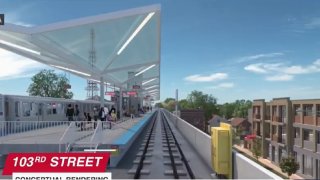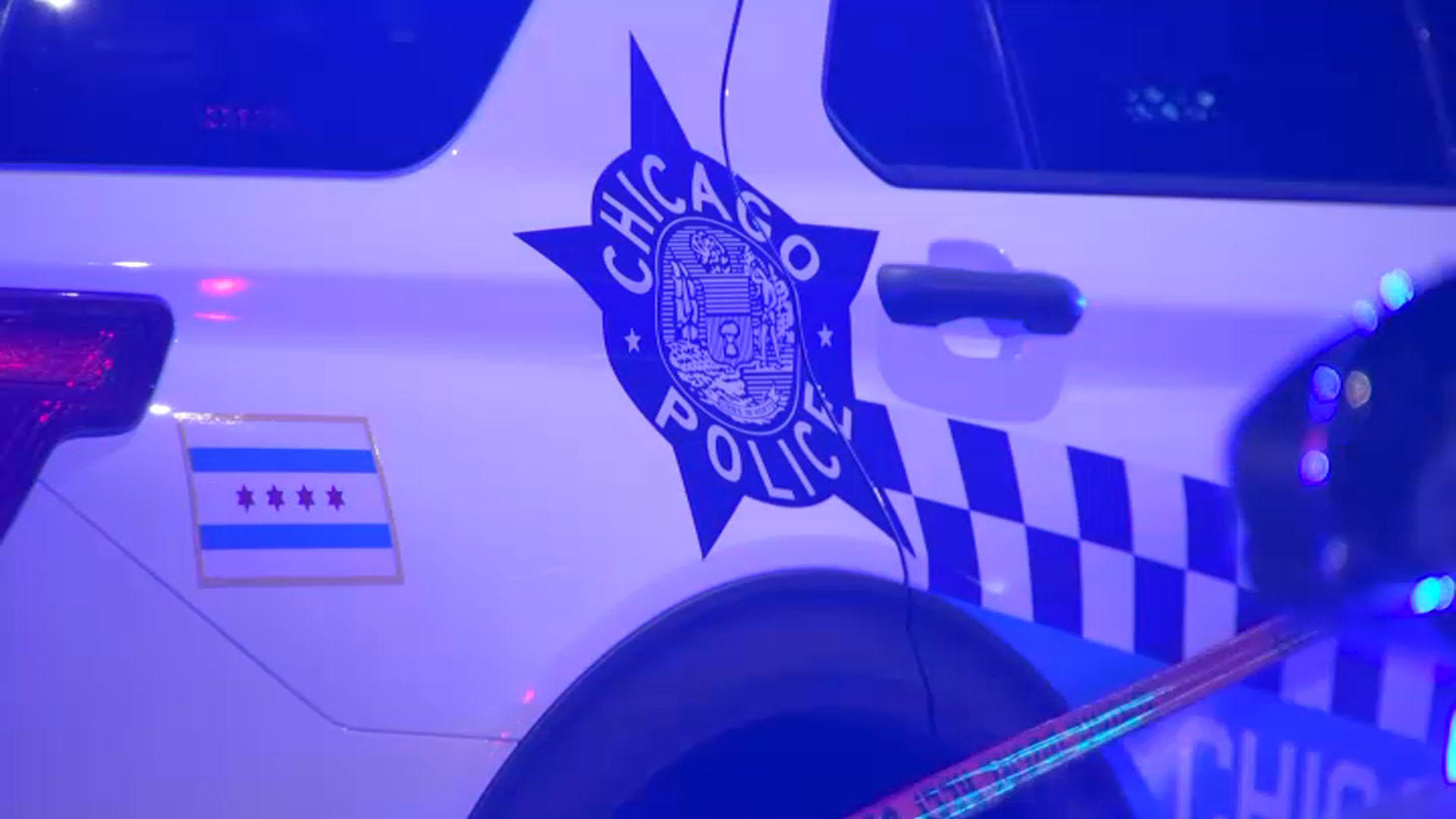
Former Mayor Richard J. Daley talked about extending the Red Line South to 130th Street.
Mayor Lori Lightfoot can now say she helped deliver the $3.6 billion extension that will finally provide mass transit service to the only part of Chicago without it.
With only one dissenting vote on five companion ordinances, the City Council made it happen on Wednesday, creating a new transit tax-increment financing district to bankroll $959 million — 26% — of the cost of extending the CTA’s Red Line from 95th Street to 130th Street, with four new stations along the way.
Those stations will be at 103rd; 111th Street near Eggleston Avenue; along Michigan Avenue near 116th Streets; and the new terminus, at 130th Street near Altgeld Gardens.
“This was a promise to our community 50 years ago. I remember as a kid growing up talking about the extension. That was a buzz throughout the community. People were saying, `When will we get ours?’ “ said Ald. Anthony Beale (9th), whose Far South Side ward would benefit the most, said as he opened debate.
“Our community has been disinvested, disenfranchised and disconnected for a very long time…We have an opportunity to turn the ship around…Look deep into your heart and fulfill the promise made 50 years ago.”
Indicted Ald. Carrie Austin (34th) urged her colleagues to “open the doors” of opportunity for “those who live that far south.” Austin noted that she “had to give up my ward” because there are fewer residents, in part, because the Far South Side is cut off from the rest of the city.
“To hinder the residents we represent is unfair,” Austin said, adding that she “doesn’t want to talk too long because, “I don’t want to run out of oxygen.”
Ald. Jason Ervin (28th), chairman of the Black Caucus, acknowledged that some of his colleagues “may not like how this is being funded.” But, he said, “To have a portion of the city disconnected has been a travesty.”
Feeling out of the loop? We'll catch you up on the Chicago news you need to know. Sign up for the weekly Chicago Catch-Up newsletter.
Retiring Zoning Committee Chair Tom Tunney (44th) said he is “totally in support” of the extension. But, he said, “We need partners at the state and the county.” He accused Cook County of “passing the buck on this.”
After the vote, Lightfoot rose from the rostrum to say that the project was a “long, long time coming.”
“It’s absolutely needed. It gives us an opportunity to take advantage of historic federal dollars,” Lightfoot said.
She thanked the Biden administration for “recognizing that there are these big, mega-projects that need federal funding—and this is one of them.”
The new TIF district is controversial because it isn’t in the area where the money will be spent — Beale has called it a “rob-Peter-to-pay-Paul” approach. The district covers a half-mile on either side of the Red Line, from Madison Street south to Pershing Road. Property tax growth over the next 35 years in that area will fund part of the $3.6 billion Red Line extension further to the south.
As a result, five wards nowhere near the Far South Side (the 3rd, 4th, 11th, 25th and 42nd) will bear the burden even though their residents are unlikely to benefit from the new service.
That’s why the mayor’s handpicked Budget Committee Chair Pat Dowell (3rd) opposes the financing plan, even though she chose not to speak on Wednesday before casting the lone “no” vote.
Dowell is all for the extension, calling it desperately needed to save time for Far South Side commuters. It will, she estimates, put “58% more jobs with a reasonable, 45-minute commute.” But she wants everyone — not just five wards — to pay.
“When you take TIF money from one neighborhood and spend it in another, it really feels like theft. It feels low down and dirty,” Dowell told CTA President Dorval Carter Jr. during a Finance Committee hearing earlier this week.
“Because these benefits are citywide, everyone should have skin in the game of paying for this project. This has to include the entire city, include the state of Illinois and Cook County. … This takes money from one area of the city and ships it miles away from the residents who generated the funding and live in these communities that still have many issues that need to be addressed.”
The new mass transit TIF is similar in concept to the one created to bankroll the Red-Purple Modernization project on the North Side.
At the urging of then-Mayor Rahm Emanuel, alderpersons hastily authorized the earlier TIF to provide $622 million in local matching funds. They were racing at the time to nail down $1.1 billion in federal funds before then-President Barack Obama left office.
But, Dowell has argued the Red Line South transit TIF is “not the same” as the one created on the North Side.
“All the communities along the North Side Red Line contributed to funding the modernization and all the communities got the benefit in terms of better service, shorter commute times, more trains. That’s not the case with the Red Line extension. Five wards pay but don’t nearly see any of the benefits,” she said.
“I’m also very concerned about taking away billions of dollars from the general fund by creating a TIF to pay for the extension. Year after year, we face financial challenges ass a city and work hard to close any budget gaps. This would not only make that more difficult. It would take away huge amounts of money I know we need to continue to operate as a city and pay for the things our communities need like public safety, affordable housing, clean drinking water and more.”
Carter has acknowledged the opposition to the Red Line TIF. But, he argued this week there is no other choice to provide the required local matching funds to access as much as $2.2 billion in federal funds.
“I wish I had other places I could go,” he told alderpersons earlier this week. “I’m happy to talk to you about where I went. But right now today at this moment, I need the help of the City Council to make this project a reality. … This community has waited over 30 years to get this. You have the opportunity to give it to them — finally.”
Carter framed Wednesday’s vote as a matter of mass transit “fairness.”
“It is not a mistake that this community on the Far South Side of the city is the only community in a city the size of ours with one of the best transit systems in the country that does not have access to rail,” Carter said.
“We have an opportunity here with this project to correct what has been [decades] of wrongdoing for this community. … It may very well be one of the biggest visionary decisions that you make as members of the City Council.”
Lightfoot essentially made the same argument last month when she launched her frenzied lobbying campaign to convince a skeptical City Council to beat her Dec. 31 deadline to provide federal matching funds.
“What I’ve heard is, ‘We did this for the North Side without any hesitation. Without any concerns. Let’s do it for the South Side. Let’s do it for these communities that have been disconnected from rail service forever,” the mayor said then.
“This is an incredibly important inflection point for rail transportation and giving those communities the same kind of investment that other communities particularly on the North Side have enjoyed for decades. This opens up so much potential on the Far South Side. I’m excited that this is happening on my watch.”
Although 40% of federal funding for new mass transit projects “must flow to disadvantaged communities,” the mayor said, “We’ve got to demonstrate to the federal government that we’ve got skin in the game. That we are willing to use our dollars to say, ‘Yes, we will match what is necessary to get this done and get it rolling.’”
Beale was just two years old in 1969 when then-Mayor Richard J. Daley opened the 95th Street Red Line station — and promised the Red Line would be extended to 130th.
Although he thanked Lightfoot during Wednesday’s debate for carrying the ball to the finish line, he told the Sun-Times that her ability to deliver the massive project that her predecessors didn’t has more to do with political good fortune than it does with the mayor’s ability to get things done.
“This phase of the seven-part funding process fell into her lap,” said Beale, the outspoken mayoral critic whose Far South Side ward stands to benefit the most.
“The credit should to me and Carrie Austin for making sure the city made this a priority to have the federal government start this process.”
Although the job-and-contract-generating project may help Lightfoot fill her campaign coffers, Beale predicted it “won’t make a difference” on whether or not she wins a second term.
“This is nowhere near enough to get her over the obstacles she faces,” he said.



